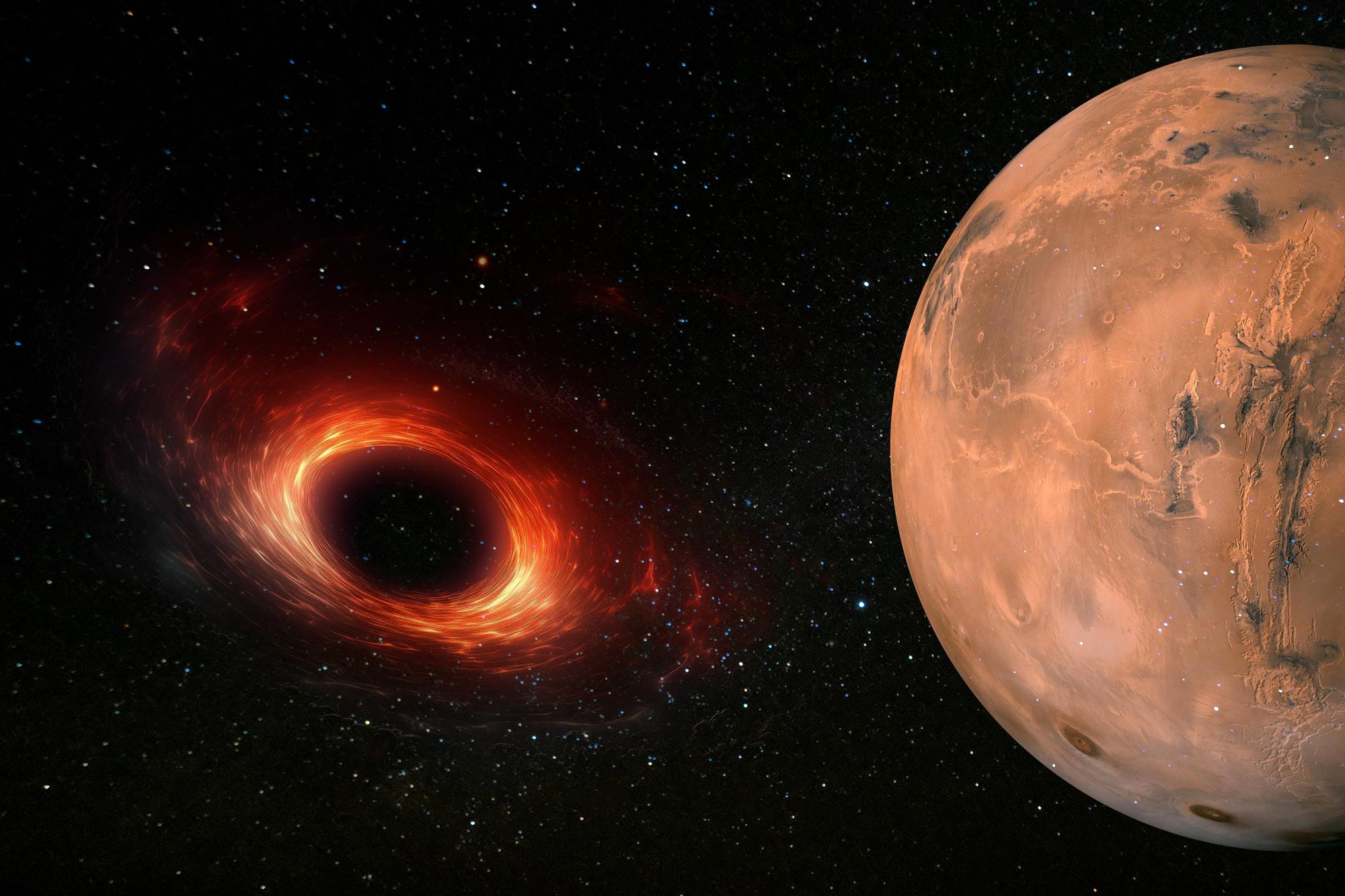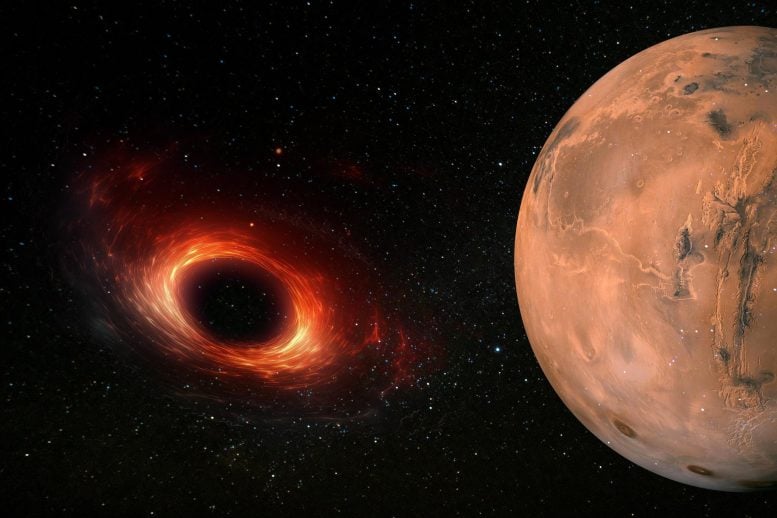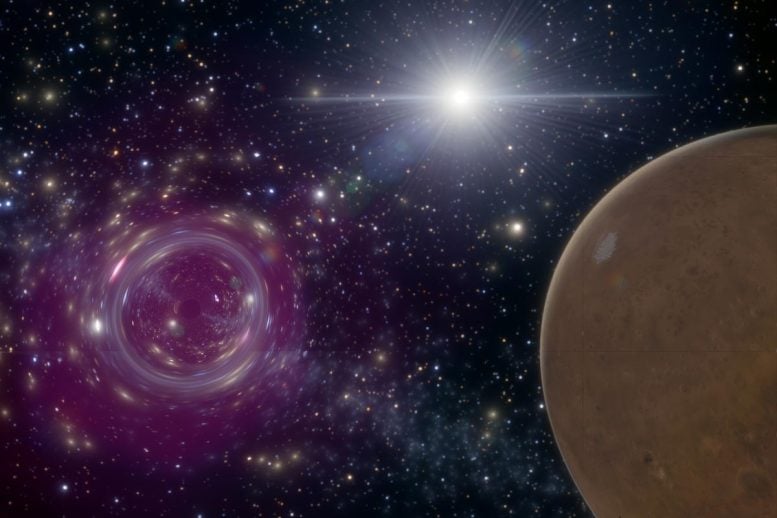

Watching for changes in the Mars’ orbit over time could be a new way to detect passing dark matter.
Dark matter, potentially in the form of primordial black holes, could be revealing its presence through subtle influences on Mars’ orbit. These black holes, theorized remnants from the early universe, might be detectable every decade as they pass through the solar system, offering a new way to study the elusive dark matter.
Understanding Dark Matter: Theories and Experiments
With less than 20 percent of all physical matter made from visible stuff—from stars and planets, to the kitchen sink—astronomers continue to hypothesize what form the invisible majority of the universe’s matter has taken. One theory states dark matter consists of weakly interacting massive particles, while another hypothesizes the existence of subatomic particles known as axions.
Physicists have erected detectors on Earth to try and spot dark matter and pin down its properties. For the most part, these experiments assume that dark matter exists as a form of exotic particle that might scatter and decay into observable particles as it passes through a given experiment. But so far, such particle-based searches have come up empty.

Primordial Black Holes: A New Form of Dark Matter
Now, a new study co-authored by Sarah Geller, a postdoctoral fellow at the Santa Cruz Institute for Particle Physics, suggests that dark matter in another form first hypothesized over half a century ago has been passing through our solar system about once per decade. That form, known as a “primordial black hole,” could cause a wobble in the orbit of Mars to a degree that today’s technology could actually detect.
The theory behind primordial black holes, first introduced in the 1970s, is that dark matter could exist in a microscopic form caused by the collapse of dense pockets of gas in the very early universe. So, primordial black holes would have formed in the first moments following the Big Bang, and would have scattered across the cosmos as the universe expanded and cooled.
Unlike the astrophysical black holes that form from the collapse of old stars, theorists say primordial black holes collapsed an enormous amount of mass into a tiny space. And even though they aren’t made of particles, the majority of these primordial black holes could be as small as a single atom and as heavy as the largest asteroids. It would be conceivable, then, that such tiny giants could exert a gravitational force that could explain at least a portion of dark matter.
Exploring Primordial Black Holes Through Solar System Simulations
“Primordial black holes do not live in the solar system. Rather, they’re streaming through the universe, doing their own thing,” Geller said. “And the probability is, they’re going through the inner solar system at some angle, once every 10 years or so.”
Geller is a former graduate student of MIT, where most of the research for this study was done. There, the team generated a relatively simple simulation of the solar system, which incorporates the orbits and gravitational interactions between all the planets, and some of the largest moons. Then, they worked out the approximate once-per-decade rate at which a primordial black hole should pass through the solar system—based on the amount of dark matter that is estimated to reside in a given region of space and the mass of a passing black hole.
In this case, they assumed it to be as massive as the largest asteroids in the solar system, consistent with other astrophysical constraints. The researchers simulated various asteroid-mass black holes flying through the solar system, from various angles, and at velocities of about 150 miles per second. (The directions and speeds come from other studies of the distribution of dark matter throughout our galaxy.)
Detecting Primordial Black Holes: Mars’ Orbital Wobble
They zeroed in on those flybys that appeared to be “close encounters,” or instances that caused some sort of effect in surrounding objects. They quickly found that any effect on the Earth or the moon was too uncertain to pin to a particular black hole. But Mars seemed to offer a clearer picture.
The researchers found that if a primordial black hole were to pass within a few hundred million miles of Mars, the encounter would set off a “wobble,” or a slight deviation in Mars’ orbit. Within a few years of such an encounter, Mars’ orbit should shift by about a meter—an incredibly small wobble, given the planet is more than 140 million miles from Earth. And yet, this wobble could be detected by the various high-precision instruments that are monitoring Mars today.
If such a wobble were detected in the next couple of decades, the researchers acknowledge there would still be much work needed to confirm that the push came from a passing black hole rather than a run-of-the-mill asteroid.
Concluding Remarks on Dark Matter Research
“We need as much clarity as we can of the expected backgrounds, such as the typical speeds and distributions of boring space rocks, versus these primordial black holes,” said study co-author, David Kaiser, professor of physics and the Germeshausen Professor of the History of Science at MIT. “Luckily for us, astronomers have been tracking ordinary space rocks for decades, as they have flown through our solar system. So we could calculate typical properties of their trajectories and begin to compare them with the very different types of paths and speeds that primordial black holes should follow.”
To help with this, the researchers are exploring the possibility of a new partnership with a group that has extensive expertise simulating many more objects in the solar system. “We are now working to simulate a huge number of objects, from planets to moons and rocks, and how they’re all moving over long time scales,” Geller said. “We want to inject close encounter scenarios, and look at their effects with higher precision.”
The study, “Close Encounters of the Primordial Kind: A New Observable for Primordial Black Holes as Dark Matter,” was published today in the journal Physical Review D.
For more on this research, see MIT Study Finds Dark Matter Detection Possible Through Mars’ Wobble.
Reference: “Close encounters of the primordial kind: A new observable for primordial black holes as dark matter” by Tung X. Tran, Sarah R. Geller, Benjamin V. Lehmann and David I. Kaiser, 17 September 2024, Physical Review D.
DOI: 10.1103/PhysRevD.110.063533
The paper’s lead author is former MIT undergraduate Tung Tran, now a graduate student at Stanford University.
This work was supported in part by the U.S. Department of Energy and the National Science Foundation (NSF). Geller’s work at UC Santa Cruz is supported by an NSF Mathematical and Physical Sciences postdoctoral fellowship.